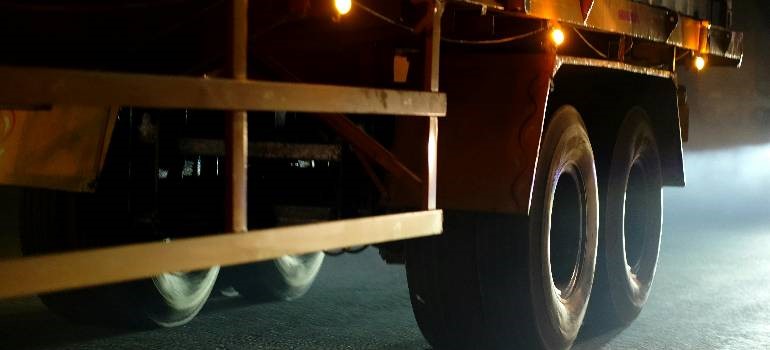Moving requires more than boxes and tape. The difference between a stressful move and an efficient one often comes down to preparation. Knowing what super organized people do before moving day helps make each step easier. This is not about perfection. It is about practical actions that reduce stress and keep the process on track. When each task is planned, the move becomes more predictable. There is time to solve problems before they cause delays. Even if movers are booked, starting early gives more control over the process. Simple steps like labeling boxes, planning furniture layouts, and packing essentials ahead of time save hours later. A move does not have to be chaotic. By following proven tips and covering often-forgotten details, anyone can be ready when the moving truck arrives.
Gather moving estimates early
Booking a mover early helps secure preferred dates and pricing. It's best to arrange approximately 3-4 estimates before the move, but price comparison isn't the only reason. Your moving consultant should have a wealth of knowledge, including how many boxes you need, if you plan on packing your own items. They can even sell you the boxes and arrange to have them delivered to you. If you choose to buy boxes elsewhere, that's fine too.

Review all contracts and paperwork before signing to avoid misunderstandings. Ask about cancellation policies and insurance coverage. Compare service quality and experience as well as cost. Ensure the moving company is licensed and insured. If you are relocating within Northern California, consider getting quotes from affordable movers in Bay Area to find competitive rates without sacrificing quality. Booking early also reduces the risk of limited availability during busy seasons. A reliable mover will answer questions about truck sizes, timelines, and special item handling.
Create a realistic packing plan
A packing plan prevents last-minute stress. Divide the number of boxes you need to pack by the number of days left before the move. Aim for higher than that number every day. Unless you are home all day, it's unlikely you'll pack more than 5-10 per day without help. Don't be ashamed to admit to your mover that you need their help, but it's best if you notify them in advance so they can allot the time and resources and update your estimate. Fear not, though, even without notice, your movers will be ready.
Keep packing materials, tape, and markers in a central location for quick access. Begin with items used less often, like seasonal clothing or décor. Save everyday essentials for last. Pack similar items together for easier unpacking. Avoid overfilling boxes to prevent damage. For those who also need temporary storage between packing phases, consider using Bay Area storage solutions to keep belongings safe until moving day.
Declutter before packing
Reducing what needs to be moved saves time and money. Start decluttering several weeks before the move. Go room by room and sort items into the following categories:
- donate
- sell
- recycle
- discard

Be realistic about what will be used in the new home.
- Sell items online or through a garage sale to earn extra cash.
- Donate usable goods to local charities
- Properly dispose of broken or expired items.
Decluttering also makes unpacking easier by reducing the number of boxes. It is easier to organize belongings when there is less to arrange. This process should be completed before serious packing begins. A cleaner, more organized home makes packing faster and helps movers work efficiently. Decluttering is one of the simplest ways to make a move less overwhelming and ensures that only useful and meaningful items make it to the new home. To help track these and other pre-move steps, follow a checklist for your move that includes pet and childcare arrangements.
Label everything for easy unpacking
Clear labels save time when unloading and unpacking. Use large, legible writing on all sides of each box. Color code by room using tape or stickers for quick identification. Mark fragile boxes clearly so movers handle them with care. Label cables and electronics to make reconnection easier in the new home. Include a short list of key contents on each box. Use reusable bins or luggage for heavy or valuable items.
Keep similar items together to avoid mixing unrelated belongings. Label hardware or screws in small bags when disassembling furniture. Number boxes in each room to ensure nothing is missed. Place labels in a visible spot so they are easy to read. If moving across the country, working with one of the best moving companies for long distance can ensure labeling systems are followed from start to finish.
Keep essential items with you
Pack essential items separately so they are always within reach. Include important documents, jewelry, and medications. Keep cleaning supplies and basic tools handy for immediate use. Prepare a suitcase for each family member with:
- clothing
- toiletries
- daily necessities
Include an “open first” box containing chargers, snacks, and basic kitchen items. Store all moving-related papers in a binder for quick reference. Carry valuables yourself rather than sending them with the moving truck. This ensures they remain safe and accessible. If moving long-distance, include air mattresses, bedding, and basic cookware for the first night. Keep a small first-aid kit in case of minor injuries. Having these essentials nearby makes the first hours in the new home easier.
Change your addresses before moving day
Address changes should be handled before the move to avoid missed mail or bills. Update:
- banks
- credit cards
- subscription services
Many changes can be completed online within minutes. Notify insurance companies, employers, and government agencies of your new address. Allow a few days for postal changes to take effect. Confirm that updates are processed by checking accounts or receiving confirmation emails.

Cancel or transfer magazine subscriptions and delivery services that will not continue after the move. Schedule final bill payments for utilities to avoid late fees. Set up mail forwarding to cover anything missed. Keep a list of all companies and contacts updated with your new details. If you are using full service moving services, your movers may offer address change reminders as part of their service checklist.
Plan furniture and access for moving day
Measuring furniture and doorways ahead of time prevents problems on moving day. Create a simple floor plan for each room and mark where large items will go. Use painter’s tape to outline placement on the floor. Tell movers in advance if large trucks cannot access your property. If a shuttle is needed, it may add to the cost. Walk the path your furniture movers in Bay Area will take and clear obstacles. Long carries from truck to home may have additional fees.
Check for narrow hallways, low ceilings, or tight staircases. Make arrangements for any disassembly before the move. This preparation speeds up unloading and helps movers place items correctly the first time. A clear plan reduces confusion and avoids moving heavy items multiple times. If moving locally, Bay Area residential movers can often provide advice on the best truck sizes and access solutions.
Schedule utilities and services in advance
Utility setup should be arranged before moving day. Contact providers and schedule shut-off and start dates for:
- electricity
- gas
- water
- internet
Avoid gaps in service by planning transfers carefully. Book installations early, especially during busy seasons. Confirm appointments to ensure service will be ready when you arrive. Notify waste collection services and arrange for any needed containers. Update home security systems if applicable.

Consider transferring or canceling pest control and lawn services. Keep all confirmation numbers and contact details in your moving binder. Having utilities active before you move in allows for immediate comfort and avoids delays. It also prevents the inconvenience of living without essential services. This step is easy to overlook but is essential for a smooth start in the new home.
Protect your home during the move
Moving heavy items can cause damage without proper protection.
- Use floor covers or cardboard to prevent scratches.
- Place blankets or padding on door frames and walls in high-traffic areas.
- Protect corners from chips by using corner guards.
- Keep cleaning supplies ready for quick touch-ups after movers leave.
- Cover railings and staircases to prevent dents and scuffs.
Inform movers about fragile surfaces like hardwood or marble. Walk through the house before movers start to point out areas needing extra care. This protects your current home and the new one. It also avoids repair costs after the move. Simple precautions keep both properties in good condition during the moving process.
Take photos before the move
Photos provide proof of the condition of items before the move. Document valuable belongings from multiple angles. Include serial numbers if possible. Photograph electronics before disconnecting to help with reconnection later. Save images to a secure location or cloud storage.

This visual record supports insurance claims if damage occurs. It also provides a reference for unpacking and setup. Taking photos takes little time but offers significant protection. It ensures you have evidence of the state of your possessions before they are loaded into the truck. This step is especially important for fragile or expensive items.
Confirm moving day details
Confirming details with your mover reduces last-minute issues. Call 24 hours before the move to verify arrival time. Confirm the number of movers assigned and the truck size. Provide access instructions, parking details, and any gate or building codes. Check weather conditions and discuss any potential delays. Having clear communication ensures both parties are prepared. This also gives a chance to address any last-minute changes or questions. A quick confirmation call can prevent misunderstandings and keep the move on schedule.
Map out everything like super organized people do before moving day
This one may seem a little over the top, but it can save you a lot of headaches on moving day. Find out what size truck a mover will bring.
- If it's a local move, ask one of the local moving companies in Bay Area for a 27 foot.
- For a long-distance move, plan on 53 feet.
If a truck of such a size will not fit, let your mover know in advance. Your move may require a shuttle, which will add to the cost.

Pace out the steps to the front door from the truck. If movers will have to go more than a certain number of feet (generally between 50 and 100), you may be charged for a long-carry. You should also map out each room. Put painter's tape down for each item of furniture. If something won't fit, it's best to know it before moving it. Having a clear idea of where to place furniture will potentially save a lot of time.
Plan meals for moving day
Moving day is busy, so plan meals ahead.
- Prepare easy snacks like sandwiches, fruit, and bottled water.
- Avoid messy foods that could spill on packed items.
- Consider scheduling delivery from local restaurants.
- Use up perishable food before moving to reduce waste.
- Keep disposable plates and utensils handy for convenience.
Having food ready prevents the need to stop during critical moving times. Staying hydrated and fed keeps energy levels steady for both you and the movers. This small step makes the day more manageable.
Have a backup plan
Unexpected changes can happen on moving day. Prepare for weather delays, traffic issues, or equipment problems. Know local storage options in case unloading is delayed. Keep extra cash available for emergencies. Have a list of alternative contacts for last-minute help. Being flexible helps manage challenges without major disruption. A backup plan ensures the move continues even if the original plan changes.
Staying on track like super organized people do before moving day
Following these steps keeps the move organized and reduces stress. Planning ahead ensures each part of the process is covered. From getting estimates to packing essentials, preparation makes a difference. Movers can handle much of the work, but personal planning gives better control. Address changes, utility setups, and labeling boxes save time later. Care for children and pets keeps everyone safe. Decluttering and protecting your home prevent extra costs. When these details are managed, the move is smoother. Staying focused on what super organized people do before moving day helps anyone complete the process successfully.
Tags
Subscribe to Upline Moving's Blog










